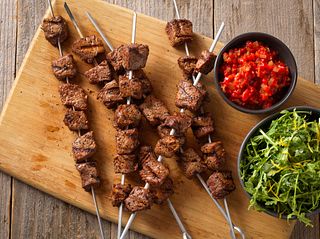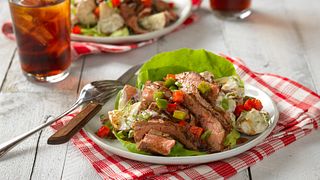Industry Stats
Get to the meat of Washington's beef industry with some facts, figures and quick information.
WAshington Beef Industry Information:
What is the economic impact of the Washington beef industry?
Although the beef industry is widely recognized as an important agricultural commodity, few studies exist evaluating its economic importance. The 2019 Contribution of the Washington Beef Sector to the Washington Economy, research conducted by Dr. Shannon Nieburgs of Washington State University, quantifies the impact of beef production on the Washington state economy. Major study findings include:
- Washington cattle production inventories based on the most current USDA reports were 228,000 calves produced, 564,000 finished feedlot steers and heifers sent to slaughter, and 1,146,000 head of cattle slaughtered.
- USDA data tracks Washington’s beef cow inventory which peaked in 1984 at 436,000 cows and has declined to 230,000 cows in 2019. Washington’s beef herd has declined at more than double the rate (down 47% since 1984) than the rest of the U.S (down 20% since 1982). However, Washington’s beef cow herd inventory has been growing since 2015 from 198,000 to 230,000 beef cows representing a inventory growth of about 16%.
- For 2019 the cattle industry generated $2.456 billion dollars in direct total output through it's cow-calf, feedlot and processing sectors combined.
- Direct cattle sales represent only part of the economic contribution of the beef industry. Input-output analysis was used to estimate the indirect effects that result from the beef industry's input purchases, labor and profits. The total economic contribution of the beef industry to Washington is $4.686 billion.
- The study goes further to capture the direct, indirect and induced impact of Washington's beef industry and found that every dollar generated directly by the cattle industry contributes an additional $1.91 in economic activity by businesses supporting the needs of the cattle industry. The "induced effect" generated an additional $868 million in economic activity.
- The total value added is the cattle industry’s contribution to state GDP, which is $1.638 billion dollars. The cattle industry's high use of in-state inputs, such as farm-produced feed and byproduct feedstuffs, and high use of labor generates $4.35 of state GDP for each dollar directly contributed to by the cattle industry.
A Family Affair
There are approximately 9,000 cattle owners in Washington. On average, these families have been operating their ranches for 47 years, some for over 100 years. Ranches in Washington are diverse in size and can be found in all 39 counties. Of the approximately 9,000 ranches and farms, about 6,000 have only ten head of cattle. Only 45 ranches have over 500 head, but represent about 63% of the beef cattle inventory.
Washington’s beef cow inventory peaked in 1984 at 436,000 cows and has declined to 230,000 cows in 2019. Washington’s beef herd has declined at a much higher rate than the rest of the U.S. According to USDA data over the same time frame, the U.S. herd peaked at 39.229 million head in 1982 and declined to 31.7 million head in 2019. This represents a 20% decline from peak to current for the U.S. beef herd. Comparatively Washington’s decline from peak to current is down 47%, a little more than double the rate of decline of the U.S. herd level. However, Washington’s beef cow herd inventory has been growing since 2015 from 198,000 to 230,000 beef cows in 2019, representing a recent inventory growth of about 16%. But big or small, it's a family tradition.
Beef Community JObs
Washington's beef community directly supplies about 3,589 local jobs. Because farms and ranches need supplies and services from local companies, and their owners and employees are all local, the total employment resulting from the industry is 15,007 jobs. The beef processing sector (slaughterhouses in Washington) directly employs the most people, with 2,684 full-time jobs.
Pen riders check cattle health each day at the feedyard on horseback. These employees monitor thousands of cattle each day. Inexperienced pen riders are matched up with an experienced rider, to be trained and gain experience reading the signs of sick and healthy cattle. Employee retention at the feedyard is a key to managing cattle health effectively and efficiently.
Cattle Feedyards in Washington
There are approximately 20-30 cattle feedyards in Washington, ranging in size. The dry, mild environment of southeastern Washington, and the close proximity to agricultural byproducts and crops make it a great location for cattle feeding. The number of cattle feedyards has decreased, while the size of ranches have increased to gain efficiency and economies of scale.
The largest feedyards are located in close proximity to the two major beef slaughter facilities in southeastern Washington. Cattle do not have to be transported far from the feedyard to slaughter, which improves animal welfare and beef quality by limiting stress. Washington's cattle feeding sector produced 564,000 finished steers and heifers in 2019 that made their way to our local processing facilities, accounting for a half of the 1,146,000 total slaughtered cattle in 2019. This is substantially lower than the top 3 feeding states, that can feed over 2 million head at one time.
what cattle eat
Washington is an incredibly diverse state for agriculture. But most of the 300-and-some-odd crops we grow have a season, a limit to where and when they grow. Not beef cattle. Our state's relatively mild climate is hospitable to raising healthy cattle year-round. And the availability of local forage and feed options for cattle is optimized when animal nutrition scientists use their expertise to feed cattle a lot more than grass and grain.
Cattle have a super power. Their four-chambered stomach allows them to eat a lot of things people can't, making the most of those 300-ish crops raised right here. Cattle upgrade plants and food byproducts that are of little-to-no value to people, into high-quality protein. It's called "upcycling," and cattle are experts. Without cattle, there would be a lot of food grown for humans and human food-processing leftovers dumped into landfills (think bruised apples, potato peels leftover from French fries, grains after they've been used for beer and even the crumbs from bakeries). The best way to explain how this works in real life is to just visit a couple of the many Washington ranchers and cattle feeders who can show and tell how it's done.
CONTRIBUTING to the economy
There are two significant beef slaughter facilities in Washington, AgriBeef's Washington Beef packing plant in Toppenish, WA and Tyson Foods Inc. packing plant in Wallula, WA. Both of these plants focus on processing feedyard-finished cattle into boxes of beef that feed Washingtonians as well as beef-consumers around the world. There are a few smaller facilities that slaughter cull cows (beef and dairy cows that have reached the end of breeding or milking productivity), and a few cooperative-founded mobile and fixed location slaughter facilities. Beef processors are the largest direct employer in Washington's cattle industry accounting for 2,684 full-time employees.
Having packing plants in Washington provides opportunities to keep cattle, and dollars, in our state from pasture to plate. The next closest plant on the west is located in Utah. Get more information about the economic impact of cattle slaughter in Washington. (picture courtesy of Agri Beef)
Learn More about the Induced Economic Impact of the Beef Industry


